Mattala, a marvel in global air travel
By Dinesh WEERAWANSA after tour of Mattala
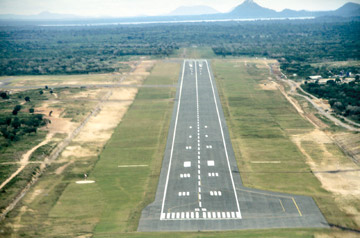 |
| MRIA has Sri
Lanka’s only runway that could facilitate landing an Airbus 380 |
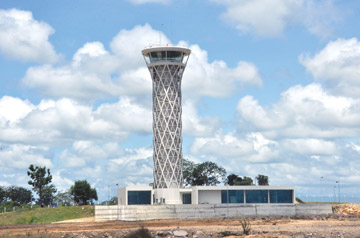
Air traffic control tower |
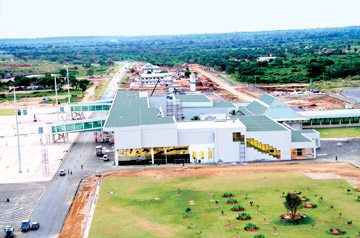
An aerial view of the terminal |
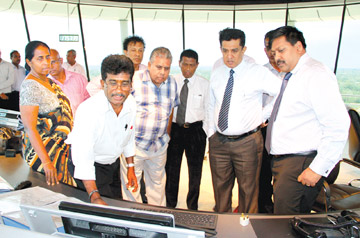
ANCL Chairman Bandula Padmakumara, Mass Media and Information
Ministry Secretary
Charitha Herath and Airport and Aviation Services Chairman
Prasanna Wickremesuriya
at the air traffic control tower |
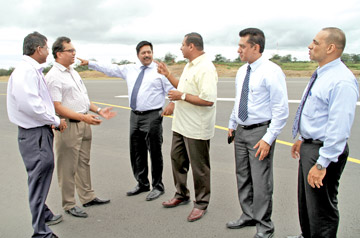
Aviation Minister Piyankara Jayaratne explains a point |
Another milestone in Sri Lanka’s forward march towards its goal of
becoming the Wonder of Asia has been achieved! A little-known village of
Mattala in the Hambantota district will become the latest addition to
international air travel maps as the new Mattala Rajapaksa International
Airport (MRIA) will be open by President Mahinda Rajapaksa in eight
day’s time.
Many scoffed at the idea when plans for another international airport
was mooted a few years ago. Some thought that it would be a daunting
task to find funds to construct a new airport. But President Mahinda
Rajapaksa was determined to gift the nation with the country’s second
international airport, little over seven years since he first assumed
duties as the Head of State.
The most impressive factor of the architecture of the MRIA is that it
has preserved the Sri Lankan identity in its construction while
incorporating modern facilities and techniques. The traditional meda
midula concept is visible in the main passenger terminal.
The four-lane motorway which connects the MRIA to Hambantota, linking
the Magampura Port and Mahinda Rajapaksa International Stadium in
Sooriyawewa gives a truly international class. As you arrive at the MRIA,
its main control tower recalls the architecture of China’s Beijing
Olympic Stadium, better known as the Bird’s Nest. The walls of the MRIA
main control tower looks very much similar to the distant look of the
Bird’s Nest, because it’s another Chinese construction.
The construction of MRIA will usher in a new era not only for people
in the Southern Province but also for those in the adjoining Eastern,
Sabaragamuwa and Uva Provinces. Thousands of new job opportunities in
various fields would be created for the people in the area as Hambantota
emerges as a commercial hub.
With MRIA emerging as Sri Lanka’s second international airport after
the Bandaranaike International Airport (BIA), the Southern city of
Hambantota will be developed as a sea-air transportation hub. The MRIA
is only 17-minutes drive from the newly built Magampura harbour.
What is unique in the commissioning of the new MRIA is that it will
offer international flights from day one. Four international airlines
have already announced their international schedules from Mattala while
several other international airlines have already expressed their
willingness to pick Mattala as their latest destination.
Apart from SriLankan Airlines and Mihin Lanka, Air Arabia and Chinese
Eastern Airlines will begin operations on the day the MRIA is
commissioned. Chinese Eastern Airlines will fly from Shanghai to the BIA
via Mattala twice a week - on Mondays and Saturdays while the local
budget airline will operate daily flights to Bodh Gaya.
The national carrier SriLankan Airlines will operate three flights a
week to Riyadh from Mattala.
There would be another flight from BIA to Beijing via Mattala
operated by the China Eastern Airlines and to Male from Katunayake via
Mattala by SriLankan Airlines while Mihin Lanka will fly to Buddha Gaya
via Mattala on Saturdays and Sundays.
Several leading international carriers, including Emirates and Qatar
Airways have shown keen interest in operating flights to MRIA, which is
being promoted on an open skies policy without any binding obligations
or regulations, mainly to avoid the congestion at BIA.
Another impressive factor at the MRIA is that its modern airstrip
could facilitate landing of the latest Airbus 380. The 3,500m Cord 4F
type run-way has a width of 75m with two Taxiways - a 360m length code F
type with a width of 60m and a 550m code C type with a width of 25m. The
MRIA is equipped with two modern aero bridges, which directly links an
aeroplane to the main arrival terminal, including a code F type one
which could facilitate an Airbus 380.
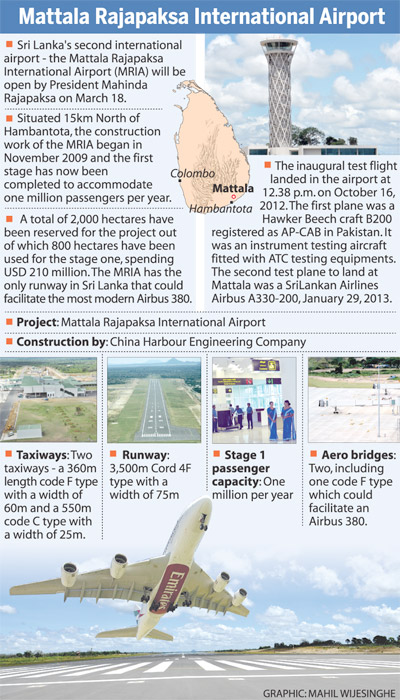 The MRIA has already secured a category 10 international
certification and would be promoted as an eco-friendly international
airport. Though it was initially planned to built the second
international airport at Weerawila, the idea was later abandoned
respecting adverse environmental reports. The MRIA has already secured a category 10 international
certification and would be promoted as an eco-friendly international
airport. Though it was initially planned to built the second
international airport at Weerawila, the idea was later abandoned
respecting adverse environmental reports.
But the 2,000 ha area for the MRIA is suitable for such projects and
all environmental precautionary measures have been followed in
constructing the airport. Initially, a total area of 800 ha have been
used for the construction under stage one. There is enough area reserved
for the second and third stages of the MRIA as it expands its operations
in future.
A botanical garden and an IT Park too would emerge along with the new
airport that would be a big boon for the travellers in Hambantota, Galle,
Matara, Ampara, Batticaloa, Badulla and Moneragala districts.
The international air travel authority has already approved eight
international routes from Mattala and the number would increase with the
arrival of several other airlines which are negotiating landing rights
at Mattala.
What is unique in the ultra-modern terminal is that it has wide range
of facilities, including 12 check-in desks, 10 emigration desks and an
equal number of immigration desks. There are provisions to expand the
number of these counters once the MRIA expands its passenger capacity.
Initially, the MRIA targets to host one million passengers a year.
Though some feared the opening of the MRIA would curtail the
operations of the BIA, it would not be so and Mattala will always be
promoted as the country’s second international airport. Apart from the
one million passengers the MRIA targets within the first year, it will
also plan to handle 45,000 mt of air cargo, which is a lucrative
business.
Civil Aviation Minister Priyankara Jayaratne scoffed at rumours that
the opening of MRIA will result in the closure of the BIA. MRIA has Sri
Lanka’s only runway that could facilitate landing an Airbus 380. He
added that many international airlines have shown keen interest to add
Mattala as their latest international destination.
Chairman of the Airport and Aviation Services, Prasanna
Wickremesuriya has worked hard to make Sri Lanka’s dream of a second
international airport a reality. He said that the MRIA will be promoted
as a transshipment hub that links to the Hambantota Magampura harbour
and a bio-diversity theme park.
The location of Mattala close to the Yala sanctuary would enable
foreign tourists to disembark at MRIA and tour the Southern area of the
country, enjoying wildlife and sunny beaches.
On completion of the stage two of the construction and development
work, the MRIA will be geared to cater to around seven million
passengers per annum. However, that would never be a threat to the BIA
operations and the country’s first international airport will be
upgraded to 15 million passengers per annum by then.
The political sagacity of President Rajapaksa has enabled Sri Lanka
to perform miracles and the construction of an international airport
would certainly be a dream come true for all Sri Lankans. Those who
scoffed at the idea of constructing another international airport four
years ago will now have to eat humble pie as Mattala begins operations
on a ceremonial note. It is definitely a dream come true for most
Southerners and all Sri Lankans could feel proud of as Sri Lanka breaks
new ground in its aviation history. Undoubtedly, the MRIA is another
landmark achievement in Sri Lanka’s victorious march to become the
Wonder of Asia.
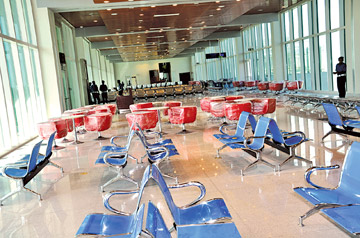 |
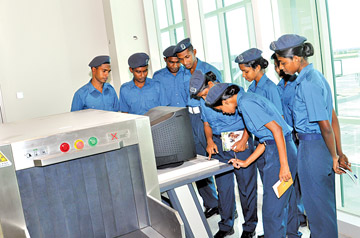 |
| Passenger terminal |
Clearance machine |
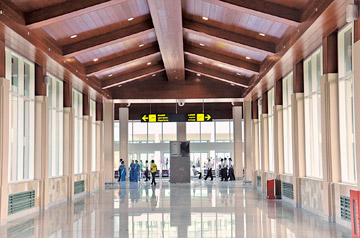 |
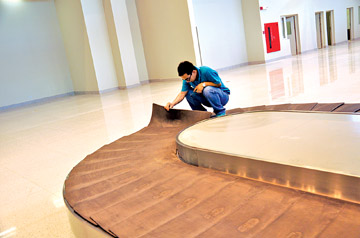 |
| Lobby |
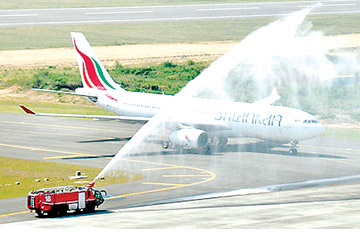 |
|
| Tarmac |
|
|



